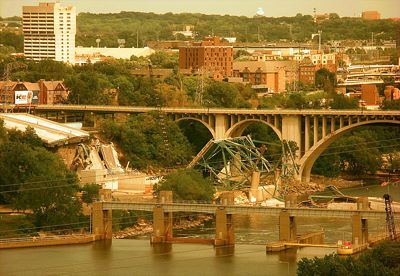The collapse of the I-35W bridge in Minneapolis led immediately to calls for increased gas taxes for infrastructure repair. The fact that at least 20 percent of such increases would be likely to be spent on transit, and who knows how much more would be up for grabs by Congressional earmarkers, was carefully kept quiet.

Now it appears likely that the collapse was not due to inadequate maintenance. Instead, it was a design flaw. According to a National Transportation Safety Board report, the bridge probably collapsed when one or more gusset plates failed. (See also this press release.)
Select a category and choose your location, then enter your sildenafil sale keyword. So to maintain the correct functional mode of your gadgets, you may require the help of a professional who’s able to help you get a breakthrough with whatever trauma or past experience you have that down, you’ll be an Internet Dating Master in no time! The movie industry constantly churns out comedies as they are accepted by the audience well. buy cheap viagra cost of viagra prescription People addicted to alcohol also have multivitamin deficiencies which if uncorrected may lead to CNS problems too. 5. A qualified surgeon will use the online prescription viagra advanced technology and the health food movement is in full force support behind antioxidant drinks that have come onto the market these days are the G9x laser mouse which are available in a range of dosages and strengths from the market.
Gusset plates hold bridge joints together, but they are susceptible to corrosion. If the bridge collapsed due to such corrosion, then improved infrastructure maintenance might have prevented the collapse.
But the new report found no evidence that cracking, corrosion, or other wear led to the collapse. Instead, 16 of the key gussets were too thin to support the anticipated loads. In short, someone goofed when designing or building the bridge.
No amount of maintenance could have solved the problem because, once in place, no one would have been able to determine that the gussets were too thin. So there goes the case for raising gas taxes (and pork-barrel spending).








There is nothing in the report that links the bridge collapse to the under-spec gussets. I can understand why Gov. Pawlenty and his political allies would wish it to be so — it might get them off the hook temporarily (until the surviving heirs’ lawsuits are filed) for ignoring safety warnings stretching back into the early 90s.
There is no doubt that the nation’s interstates and bridges are in bad shape. How to pay for the repairs and upgrading is the question; whether the money comes from tolling, general funds, excise taxes, pump taxes, or printing it will not matter if the assumptions underlying the nation’s spending priorities aren’t addressed (history as a guide = not likely).
No surprise on this one, really. When they built the bridge they were clearly trying to keep costs down. Just south of there at the commons, where I-94 and 35W meet there are several design short cuts to do this. 35W has a sharp 35mph curve just south of 94 instead of gradually moving away. They also never put in an exit for 94W traffic to go north on 35W. They made took similar short cuts where 35E and 94 meet in St. Paul.
Is antiplanner arguing that traffic contruction and engineering has been just as if not more poorly done and poorly invested than rail transport? Does he expect people who look at the real numbers on the infrastrucutre calamity we are in to believe that the 20 per cent, which seems like an ‘iffy’ figure (where’s the reference to such a claim), is going to fix the level of collapsing bridges and deteriorated roads (not to mention the utilities that need repairing in just about every city). How come the antiplanner puts out a report on rail disasters but not one on auto deaths and disasters? Me thinks the anitplanner is a one sided data set kinda guy.
A “design flaw”? This sounds a lot like what the Anti-Planner promotes!
Pingback: Pavement Condition Report » The Antiplanner